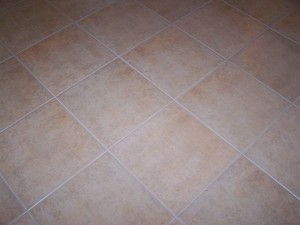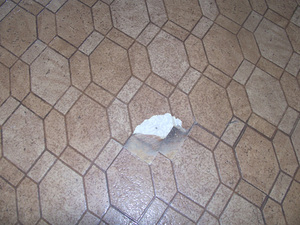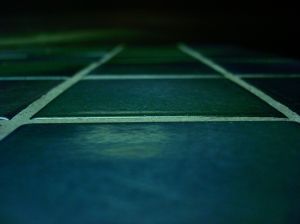Deciding that you are going to install a ceramic tile floor is a big commitment. It is something that has the potential to beautify your home while raising its value, but it can also be disastrous if you don’t know what your doing. Installing ceramic tile yourself can be less expensive that having someone else come in a do linoleum. It also provides you with the opportunity to work around your appliances at the time it will be most convenient for you to be without them. This job also, however, has the potential to cost more than you think it will. Make sure you have reviewed all of your expenses before you start ripping up your old flooring.
Prepping Your Work Area
Before you’re ready to put things down, your going to start ripping things up. Remove all of your base molding and door casing in the areas where you will be replacing your floor. Also, you’re going to have to make a decision regarding your interior doors. Your job will look crisper if your remove the entire pre-hung unit (door and frame) and install it again after you’re done. If you’re comfortable to do this, it will pay off. If not, take the door off the hinges and remove it from your work area. Also take down the doorstop from the inside of the frame.
Once you’ve got all of your trim down, it’s time to make decisions about fixtures. If you’re working in a bathroom, you should consider removing your toilet, especially if there is any consideration of replacing it in the future. Also, if you are considering replacing your bathroom vanity at some point (see Vanity Looking too Humble? DIY Guide to Replacing Your Bathroom Vanity to get an idea of what’s involved in that project), remove that as well. If you don’t, you’ll have to be sure to buy fixtures that are larger than what you already have if you decide to replace them down the line.
You’ll also have to decide whether or not you want to rip up your old floor. If your old floor is ceramic, you’ll have to rip it up. If it’s linoleum, you can do it at your discretion. Chances are, the linoleum is installed over a lauan underlayment. This underlayment is actually what you would be ripping up. It might be difficult to take up if you have cabinetry installed over it because the lauan will not be easy to cut out underneath the overhang of your cabinets. Remember, though, if you do not take out your old floor, when you put down the tile, you will raise the height of your floor which may cause you to have to rip ¼” to ½” off of your interior doors if you opted not to remove the frames. If this is the case, you may want to reconsider removing your doorframes. Now, walk over your floor listening for any squeaks. If you hear any, try to screw your subfloor to the floor joist in that spot. This may eliminate or minimize the noise your floor makes.
The last thing that you’ll need to do before you move on is clean the area. Give it a quick sweep and vacuum all of the edges and corners.
Installing Your Underlayment
Before you go ahead and start laying tile, you’re going to have to put down an underlayment surface. In the past, lauan was popular, but cement tile backer board is used more frequently now because of its ability to adhere to mortar and the ease of working with it. Hardibacker is probably the biggest name on the market and it is a very easy product to work with.
Many backer board warranties will require that you apply the backer to your subfloor with a thin-set (a type of mortar used in tile work) and then screw it down with tile backer screws. Like most installation instructions, this is a little bit of overkill. It will also add a lot of work if you had decided to install your new floor over a linoleum floor, as you would have to rip the linoleum floor out in order to apply the thin-set. Applying the backer board with a thin-set is only really necessary if you are using the thin-set to level out an uneven floor. In this case, though, you will need to have some solid masonry skills. Tile backer board can be cut by scoring it with a tile backer knife and snapping it. Irregular cuts can be made by using a circular saw with a carbide-tipped blade. Be sure to wear safety glasses while doing this because it will create a lot of dust.
Space your backer board according to the manufacturer’s recommendations, usually about 1/8″, and you’re ready to screw down. Though tile backer screws are available, drywall screws work fine and are a lot less expensive. Just make sure to follow the recommended screw pattern. If you are using Hardibacker, it is marked on the board for you.
Selecting a Tile and Pattern
Selecting a tile is basically a matter of style selection, but there are a few things about the installation process to consider. First, don’t buy a real thin tile as they crack more easily. Second, tiles from the box stores are generally less expensive, but may have lesser quality control, vary in size, and come cracked in the box. Third, bigger tiles require a bigger saw. When you pick your thin-set, just make sure that you buy a good one. It will probably cost you about $26 for the bag. Some thin-sets are only $12 a bag, but this is not the place to save money.
If this is your first tile job, don’t pick an intricate maze pattern, but you don’t have to go too basic either. A straight ninety degree pattern may seem to be the easiest and it does involve the least amount of waste, but it is a little outdated and makes your mistakes easier to see. A forty-five degree angle pattern is almost as simple as the previously mentioned, but has more of a modern look and is a bit distracting, helping to hide minor glitches in the floor.
The final thing that you need to do is decide where to start. Pick the most open and prominent area of your floor, and make sure that the tile will lay out nicely there. Everything else will fall into place.
Supply Checklist
Before you start laying tile, make sure you have the following list of items: tile, thin-set, wet saw, tile cutter, bucket, tile nipper, file, tile spacers, notched trowel, flat trowel, rubber mallet, knee pads, and a sponge.
Laying the Tile
Put on your knee pads and you’re ready to lay your tile. Start with mixing your thin-set. The instructions will tell you to mix the whole bag at once, but this can be very wasteful. Mix a small amount and see how you do. Successfully mixed thin-set with have the texture of a smooth cement. It should not be a watery or clumpy.
Apply a skim coat of the thin-set to a small section the tile backer with the smooth side of the trowel. Then apply the thin-set with the notched side of the trowel only in the area of the single tile that you want to set. Set the tile with your hands and press down. Then lightly tap down with the rubber mallet.
Now, do the same thing for your next tile. Use your tile spacers to keep your tile evenly spaced. Once you have two tiles set next to each other, use a damp sponge to clean up any extra mortar that may have come up through the space between the tiles.
Doing straight cuts on your tiles it pretty self-explanatory, but here are some pointers on cutting around doorways and other objects. First of all, don’t try to do all of your cuts ahead of time. Do them as you go. This will allow for maximum accuracy. To cut around an object, use your wet saw to cut two lines into the tile. Then use your tile cutter to score a line between your two cuts and break the tile off. Your other option is to use your wet saw to cut a series of parallel lines about ¼” apart. Then, break off your tile and clean up the edge with a nipper and file. When installing these cut tiles, do not press down hard or hit with the mallet. They break very easily.
You may come to a point in your floor where a minor crest causes a problem with laying a tile where you can’t get both sides to adhere to the backer board. When this happens, lay a 2×4 on each side of the tile and stack some weight across both boards. This will make the tile flex and help it to adhere to the floor.
Grouting
Grouting is a pretty simple task. First, make sure that your spaces are clear of thin-set. If they’re not, cut it out with a grout saw and scrape the edges with a tile scraper. Mix your grout to a smooth consistency and apply with a grout float. After allowing it to set for about twenty minutes, clean up excess with a mildly damp sponge. Allow to set for three days and apply grout sealer.
Well, that’s it. You’re done. Just remember as you look at your floor, minor flaws are a part of construction and no one can see them the way you can



